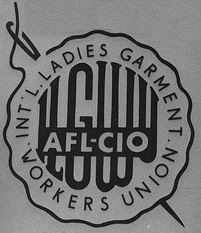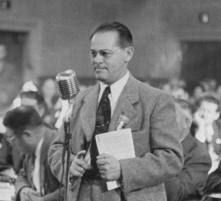
The United Mine Workers of America is a North American labor union best known for representing coal miners. Today, the Union also represents health care workers, truck drivers, manufacturing workers and public employees in the United States and Canada. Although its main focus has always been on workers and their rights, the UMW of today also advocates for better roads, schools, and universal health care. By 2014, coal mining had largely shifted to open pit mines in Wyoming, and there were only 60,000 active coal miners. The UMW was left with 35,000 members, of whom 20,000 were coal miners, chiefly in underground mines in Kentucky and West Virginia. However it was responsible for pensions and medical benefits for 40,000 retired miners, and for 50,000 spouses and dependents.

The 1936–1937 Flint sit-down strike against General Motors changed the United Automobile Workers (UAW) from a collection of isolated locals on the fringes of the industry into a major labor union and led to the unionization of the domestic United States automobile industry.

The International Union, United Automobile, Aerospace, and Agricultural Implement Workers of America, better known as the United Auto Workers (UAW), is an American labor union that represents workers in the United States and Canada. It was founded as part of the Congress of Industrial Organizations (CIO) in the 1930s and grew rapidly from 1936 to the 1950s. The union played a major role in the liberal wing of the Democratic Party under the leadership of Walter Reuther. It was known for gaining high wages and pensions for auto workers, but it was unable to unionize auto plants built by foreign-based car makers in the South after the 1970s, and it went into a steady decline in membership; reasons for this included increased automation, decreased use of labor, movements of manufacturing, and increased globalization.
The Communist Party USA and its allies played an important role in the United States labor movement, particularly in the 1930s and 1940s, but never succeeded, with rare exceptions, either in bringing the labor movement around to its agenda of fighting for socialism and full workers' control over industry, or in converting their influence in any particular union into membership gains for the Party. The CP has had only negligible influence in labor since its supporters' defeat in internal union political battles in the aftermath of World War II and the CIO's expulsion of the unions in which they held the most influence in 1950. After the expulsion of the Communists, organized labor in the United States began a steady decline.

The American Federation of Labor (AFL) was a national federation of labor unions in the United States founded in Columbus, Ohio, in December 1886 by an alliance of craft unions disaffected from the Knights of Labor, a national labor union. Samuel Gompers of the Cigar Makers' International Union was elected president at its founding convention and reelected every year, except one, until his death in 1924.

The labor history of the United States describes the history of organized labor, US labor law, and more general history of working people, in the United States. Beginning in the 1930s, unions became important components of the Democratic Party. Some historians question why a Labor Party did not emerge in the United States, in contrast to Western Europe.

The International Association of Machinists and Aerospace Workers (IAM) is an AFL-CIO/CLC trade union representing approx. 646,933 workers as of 2006 in more than 200 industries with most of its membership in the United States and Canada.

The International Ladies' Garment Workers' Union (ILGWU) was once one of the largest labor unions in the United States, one of the first U.S. unions to have a primarily female membership, and a key player in the labor history of the 1920s and 1930s. The union, generally referred to as the "ILGWU" or the "ILG," merged with the Amalgamated Clothing and Textile Workers Union in the 1990s to form the Union of Needletrades, Industrial and Textile Employees (UNITE). UNITE merged with the Hotel Employees and Restaurant Employees Union (HERE) in 2004 to create a new union known as UNITE HERE. The two unions that formed UNITE in 1995 represented 250,000 workers between them, down from the ILGWU's peak membership of 450,000 in 1969.
The Steel Workers Organizing Committee (SWOC) was one of two precursor labor organizations to the United Steelworkers. It was formed by the CIO on June 7, 1936. It disbanded in 1942 to become the United Steel Workers of America.

Amalgamated Association of Iron and Steel Workers was an American labor union formed in 1876 to represent iron and steel workers. It partnered with the Steel Workers Organizing Committee and CIO, in November 1935. Both organizations disbanded May 22, 1942, to form a new organization, the United Steelworkers.

Emil Rieve was an American labor leader. He was president of the Textile Workers Union of America (TWUA) from 1939 to 1956, a vice president of the Congress of Industrial Organizations (CIO) from 1939 to 1955, and a vice president of the AFL-CIO from 1955 to 1960.
Cyrus S. Ching was a Canadian-American who became an American industrialist, federal civil servant, and noted labor union mediator. He was the first director of the Federal Mediation and Conciliation Service (FMCS) and the Wage Stabilization Board.

Benjamin Gold (1898–1985) was an American labor leader and Communist Party member who was president of the International Fur and Leather Workers Union (IFLWU) from 1937 to 1955.

The Little Steel strike was a 1937 labor strike by the Congress of Industrial Organizations (CIO) and its branch the Steel Workers Organizing Committee (SWOC), against a number of smaller steel producing companies, principally Republic Steel, Inland Steel, and Youngstown Sheet and Tube Company. The strike affected a total of thirty different mills belonging to the three companies, which employed 80,000 workers. The strike, which was one of the most violent labor disputes of the 1930s, ended without the strikers achieving their principal goal, recognition by the companies of the union as the bargaining agent for the workers.
The 1935 Pacific Northwest lumber strike was an industry-wide labor strike organized by the Northwest Council of Sawmill and Timber Workers' Union (STWU). The strike lasted for more than three and a half months and paralyzed much of the lumber industry in Northern California, Oregon and Washington state. Although the striking workers only achieved part of their demands, the repercussions of the long and often violent strike were felt for decades. Over the next several years, a newly radicalized and militant generation of lumber workers would go on to spark several more industry-wide strikes.

The Oakland general strike took place on December 3, 1946, in Oakland, California. The strike followed an earlier strike by 400 female employees of Hastings and Kahn's, who had walked out in the fall of 1946 because of the resistance Oakland's retail merchants had to unionization.

The International Longshore and Warehouse Union (ILWU) is a labor union which primarily represents dock workers on the West Coast of the United States, Hawaii, and in British Columbia, Canada. It also represents hotel workers in Hawaii, cannery workers in Alaska, warehouse workers throughout the West and bookstore workers in Portland, Oregon. The union was established in 1937 after the 1934 West Coast Waterfront Strike, a three-month-long strike that culminated in a four-day general strike in San Francisco, California, and the Bay Area. It disaffiliated from the AFL–CIO on August 30, 2013. In 2014, the San Francisco Chronicle described the ILWU as "the aristocrat of the working class; a top member can earn well over $100,000 a year with excellent benefits", with vacancies receiving thousands or sometimes even tens of thousands of applications. Union officials claim that in the Puget Sound area, such pay numbers are inflated because they do not include "casuals", part-time workers who are not registered ILWU members, do not receive benefits and earn less, with the minimum being $25.71 per hour.

The Congress of Industrial Organizations (CIO) was a federation of unions that organized workers in industrial unions in the United States and Canada from 1935 to 1955. Created in 1935 by John L. Lewis, who was a part of the United Mine Workers (UMW), it was originally called the Committee for Industrial Organization but changed its name in 1938 when it broke away from the American Federation of Labor. It also changed names because it was not successful with organizing unskilled workers with the AFL.
Hershey, Pennsylvania witnessed a six-day sit-down strike of workers at the Hershey Chocolate Corporation in 1937. The strike ended in violence, as dairy workers and loyal Hershey employees stormed the factory to force out strikers. Eventually, Hershey Corporation workers signed an agreement with the American Federation of Labor through the Bakery and Confectionery International Union, becoming one of the first American candy companies to unionize.
The Chrysler Auto Strike began in October 1939 in Detroit, Michigan, as a struggle between the Chrysler Auto manufacturer and The International Union, United Automobile, Aerospace and Agricultural Implement Workers of America, better known as the United Automobile Workers (UAW). The strike began in October 1939 in Detroit, Michigan.












